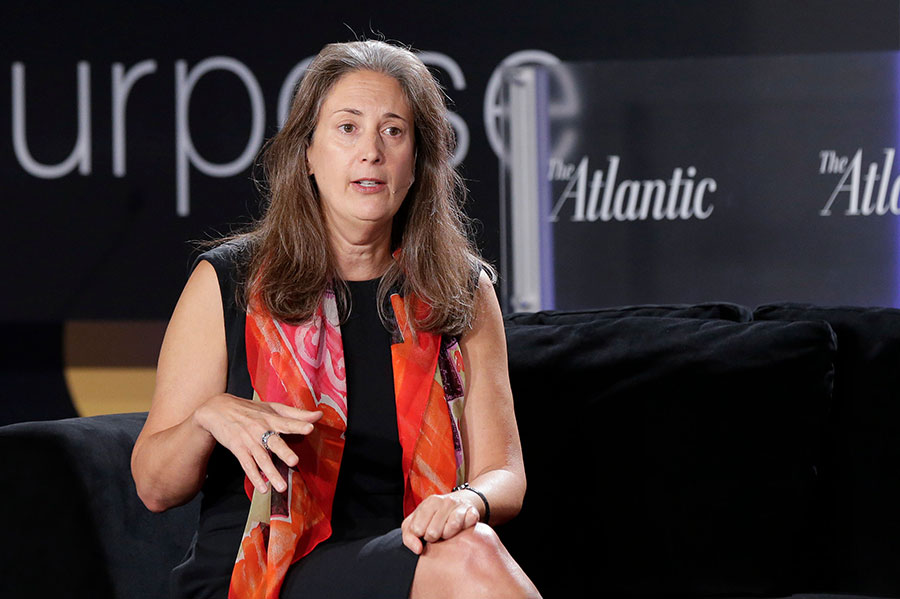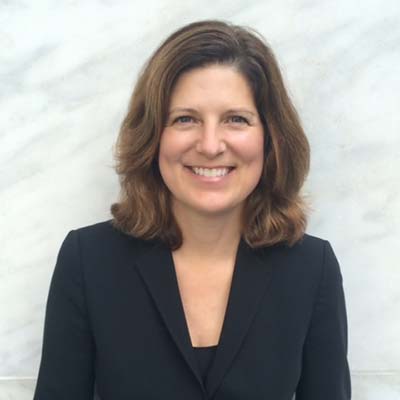 Laura Callanan is a weaver. As Founder of Upstart Co-Lab, she is intertwining impact investors with the creative economy to strengthen communities and solve global problems.
Laura Callanan is a weaver. As Founder of Upstart Co-Lab, she is intertwining impact investors with the creative economy to strengthen communities and solve global problems.
Since 2016, Upstart has been exploring how the $763 billion creative economy in the U.S. can become more inclusive, equitable, and sustainable. By introducing a Creativity Lens, Upstart Co-Lab helps impact investors who understand the power of art, design, culture, heritage, and creativity to see the opportunities that align with their values.
Before launching Upstart, Laura served as senior deputy chair of the National Endowment for the Arts and was an executive at McKinsey & Company, the United Nations and the Rockefeller Foundation. Laura was the only arts leader named by The NonProfit Times to the Power and Influence Top 50 in 2017. Our exclusive Real Leaders interview with Laura is below.
What is the Creative Economy? How do you and others define it?
The “creative economy” was defined by the British author John Howkins in 2001 as a new way of thinking and doing that revitalizes manufacturing, services, retailing, and entertainment industries with a focus on individual talent or skill, and art, culture, design, and innovation.
Today, creative economy definitions are typically tied to efforts to measure economic activity in a specific geography. A relevant set of art, culture, design, and innovation industries is determined, and the economic contribution of those industries is assessed within a region. A unique set of industries defines each local creative economy reflecting the culture, traditions and heritage of that place.
Based on industry research, Upstart Co-Lab identified five creative economy categories: Creative Places, Ethical Fashion, Social Impact Media, Sustainable Food, and Other Creative Businesses.
How do you measure its impact?
Like other social purpose businesses, Creative Businesses can follow B Lab and Global Impact Investing Rating System (GIIRS) standards and contribute to an energetic local economy by providing goods and services, creating jobs, building community wealth and helping establish a sense of community.
We found 24% of B Corporations in the U.S. are in the creative economy and, anecdotally, that many entrepreneurs in the creative economy gravitate towards a social purpose business as opposed to a conventional business.
But aside from being operated sustainably, Creative Businesses drive social impact across many thematic areas. Farm-to-table restaurants create a market for local, organic, sustainable farmers. Fashion designers build their brand connected to ethical and sustainable practices throughout their supply chain. Video game developers produce titles that help patients manage chronic disease, as well as teach players about issues like civics, peace-building, and empathy.
Why is the Creative Economy an important part of the health of a community?
Investable opportunities in the Creative Economy have the potential to stabilize threatened communities and benefit regions looking to attract and develop quality jobs. While community development finance institutions have been deploying capital into Creative Places and Businesses for decades, these investments have been categorized as affordable housing, community facilities or small businesses – with no attention to their creative characteristics.
But the opportunity to garner a financial return and create social impact through art, culture, design and innovation has never been stronger. Creative placemaking has become a core component of comprehensive community development. Artists and designers are founders of some of the leading companies of the internet age, and the cross-over between sustainability and the Creative Economy is demonstrated by successful B Corporations like Kickstarter and Etsy.
Have impact investors embraced the Creative Economy?
Contrary to conventional wisdom that believes there’s a dearth of impact investments in this segment of the economy, Upstart Co-Lab’s new study found impact investing in the creative economy has been “hiding in plain sight.”
With a dataset pulled primarily from publicly available lists and previously published primary research, Upstart Co-Lab identified more than 100 funds, representing an estimated $60 billion AUM, that have been active in the creative economy.
Significant investment has been undertaken by Impact investment funds, Sustainable & Responsible funds, and Conventional funds. Investment has been particularly strong in the private equity, private debt and real estate asset classes.
Lack of visibility and intention means that when investors ask their wealth advisors for opportunities to invest for impact in the creative economy, they are told the opportunities don’t exist. This simply is not true.
Tell us about how Upstart Co-Lab is championing the Creative Economy and advancing the idea of artists as social entrepreneurs?
Taking a page from the playbook for gender lens investing, Upstart is defining a Creativity Lens to help impact investors see how the creative economy will help them do well and do good; building a coalition of stakeholders to give this new idea traction; and helping bring opportunities to market so impact investors can put these ideas into practice.
The Upstart team curates a portfolio of projects designed and implemented with strategic partners including: Artspace, Calvert Foundation, Emergence Creative, Local Initiatives Support Corporation, and Shift Capital.
You partnered with LISC NYC to launch the NYC Inclusive Creative Economy Fund at SOCAP18. What impact are you seeking with this investment?
The Fund is a unique opportunity to channel impact investment toward catalyzing and maintaining affordable spaces, which can help businesses in the creative economy thrive. This will preserve creative spaces in NYC’s neighborhoods and provide quality jobs that can revitalize communities.
Donors at ImpactAssets were anchor investors for the Creative Economy Fund. What role can innovative philanthropic capital—and specifically donor advised funds—play in the growth of the creative economy?
Innovative philanthropic capital can open the door for other capital that is less familiar with impact investing. In the case of the creative economy, that means endowed cultural institutions.
In the U.S., museums, performing arts centers and other institutions connected to art, design, culture, heritage and creativity have more than $58 billion in assets under management but have been sitting on the sidelines of impact investing.
The creative economy can be the door to welcome these institutions into a larger conversation about aligning their financial assets with their missions and values.
What haven’t I asked you?
As the investable opportunity at the intersection of cultural diversity and the creative economy is better understood, a creativity lens will be increasingly relevant for a diversity of market contexts and fund types. It is likely that conventional investing activity in this sector will grow to take advantage of the money-making potential food, fashion, media and other creative sectors have to offer; commercial real estate developments anchored around creativity and innovation, or offering art and culture amenities, already exist.
It is exactly because of the viability and projected growth of this segment of the economy that the continuing and increasing engagement of impact investors will be crucial to ensuring a truly inclusive, equitable and sustainable creative economy with benefits for all.




































